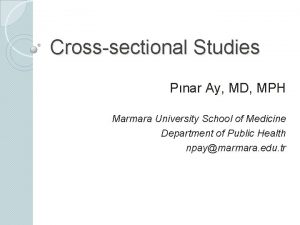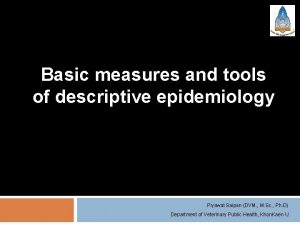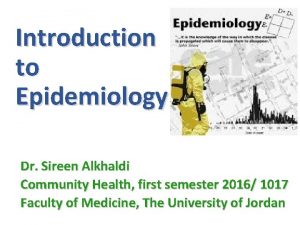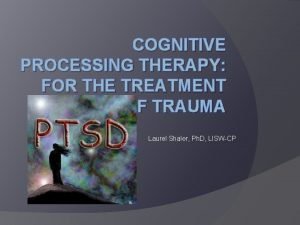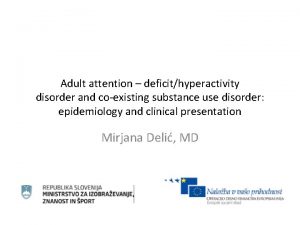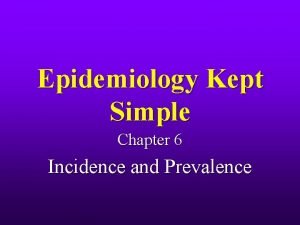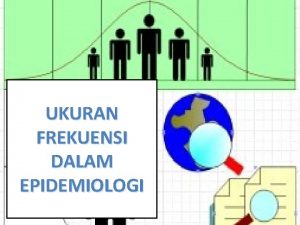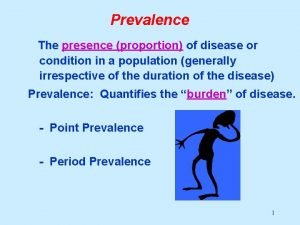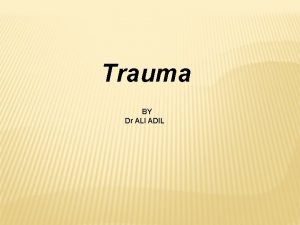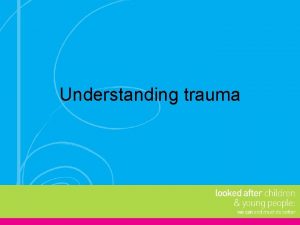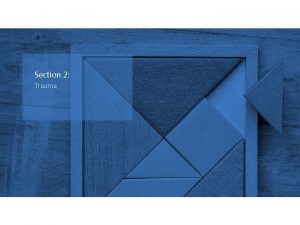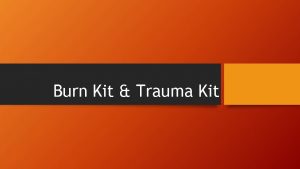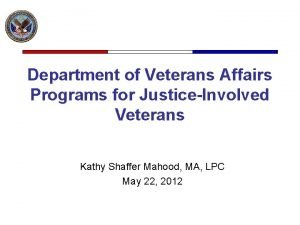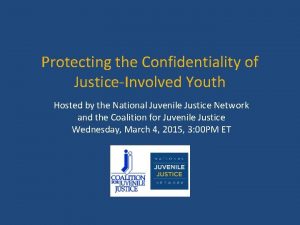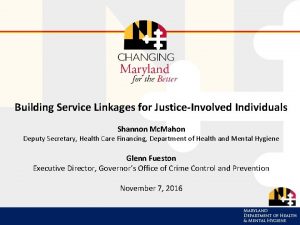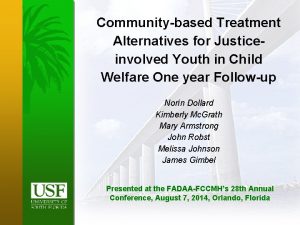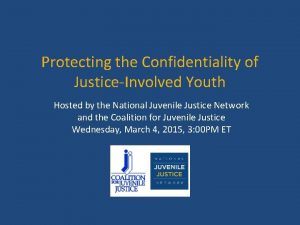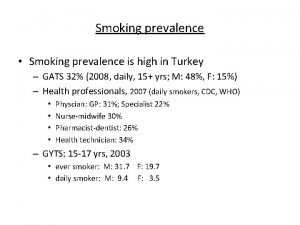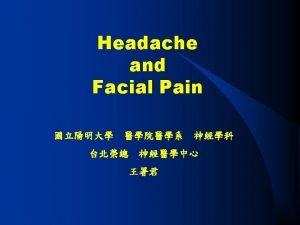The Prevalence Potential Impact of Trauma on JusticeInvolved






























- Slides: 30

The Prevalence & Potential Impact of Trauma on Justice-Involved Youths Lisa Callahan, Ph. D September 18, 2017 http: //www. samhsa. gov/gains-center © 2016

Background Science o Adolescent brain development o Observable impact of trauma on adults Money o Cost of justice system Politics o “Raise the age” o Acknowledgement of trauma in other populations (e. g. soldiers) http: //www. samhsa. gov/gains-center © 2016

SAMSHA’s Definition of Trauma Individual trauma results from an event, series of events, or a set of circumstances that is experienced by an individual as physically or emotionally harmful or threatening and that has lasting adverse effects on the individual’s functioning and physical, social, emotional, or spiritual wellbeing. http: //www. samhsa. gov/gains-center © 2016

Event Experience Effect

Examples of Traumatic Events Children Experience Intentional trauma – abuse, bullying, rape, violence in community, exposure to violence Unintentional trauma – sudden death or illness of loved one, serious injuries/illness, separation from care giver, family disruption Other types – historical trauma, community trauma, poverty, homelessness, vicarious trauma, ethnic cleansing, war http: //www. samhsa. gov/gains-center © 2016

Risk Factors for Trauma in Youths • • Race/ethnicity LGBTQ Socio-ecological factors (e. g. poverty) Lower cognitive abilities Negative cognitive bias for coping Personality disorder (e. g. hostility) Mental illness Psychophysiological factors http: //www. samhsa. gov/gains-center © 2016 Di. Gangi & et al. , 2013

Long-term Effects of Trauma Physical Health Issues Substance Fear Abuse Powerlessness Mental Health Issues Anger Pain Poor Relationships Behavioral Problems http: //www. samhsa. gov/gains-center © 2016

Signs of Trauma in Youths • Aggression & anger • Anxiety & depression • Conduct disorder/opp-defiant behavior • Distrust • Hyperarousal • Impaired information processing • Impulse control problems • • • Problems with personal boundaries Sleep disruption School problems Somatic complaints Substance use Suicidal ideation/attempts/selfharm http: //www. samhsa. gov/gains-center © 2016

Behavior – Coping & Survival • • • Hopelessness (indifference) Aggression (self & others) Hypervigilance (distrustful) In the moment, unfocused (no goals) Resentful (holds grudges) When the brain is stressed – a person cannot think, plan, or execute. http: //www. samhsa. gov/gains-center © 2016

Trauma is part of the puzzle Substance Use Trauma Mental Disorder http: //www. samhsa. gov/gains-center © 2016

How pervasive is childhood trauma? http: //www. samhsa. gov/gains-center © 2016

Adverse Childhood Events (ACE) Comparison Across Samples US Adults 1 N=17, 000+ ATC 2 N=90 JMHC 3 N=54 CA – CHC 4 N=701 FL – Boys 5 N=50, 000+ FL – Girls 6 N=17. 000+ Physical Abuse 11% 70% 27% 6% 39% 11% Emotional Abuse 28% 93% * 5% 41% 28% Sexual Abuse 21% 31% 22% 4% 31% 21% Emotional Neglect 15% 94% 56% 12% 39% 15% Physical Neglect 10% 29% 2% * 18% 10% Mother/Other HH Treated Violently 13% 83% 24% 11% 84% 13% HH Substance Abuse 27% 45% 43% 25% 30% 27% HH Mental Illness/Suicide 19% 37% 44% 11% 12% 19% Parents Sep/Div, 1/0 Parents 23% 68% 62% 84% 23% HH Member Incarcerated 5% 30% 35% 12% 68% 5% 1 2 Feletti et al. , 1998 IL Tx Ct 3 Callahan et al. , 2014 Fox et al. , 2015 4, 5 http: //www. samhsa. gov/gains-center © 2016

Trauma & Justice-involved Youth • NCTSN Study – justice-involved youth ages 13 -18 (N=658) • Findings: • Average # of trauma types ~5 • PTSD – 24% clinical range • Academic problems – 72% • Substance use – 44% • Child welfare involvement – 42% • Age of onset – 1 st year of life 34%, ages 1 -5 28% • Multiple traumas – 90% http: //www. samhsa. gov/gains-center © 2016 Dierkhising, Ko, et al. , 2013

National Survey of Children’s Exposure to Violence • Random national sample of 4000 children in U. S. ages 0 -18 • Findings: • 37% experienced a physical assault in past year, peaks ages 6 -9 (51% over lifetime) B>G • 5% experienced a sexual assault in past year, peaks ages 14 -17 (8. 4% over lifetime) G>B • 15% experienced any maltreatment in past year, peaks 14 -17 (25% over lifetime) B=G • 27% experienced any property crime in past year, peaks 14 -17 (41% over lifetime) B>G • 25% witnessed violence in past year, peaks 14 -17 (38% over lifetime) B=G; boys more likely to witness community violence and girls family violence http: //www. samhsa. gov/gains-center © 2016 Finkelhor, Turner, Shattuck, & Hamby, 2015

National Crime Victim Survey (NCVS) • 2005 -2014, 12 -17 years old • Findings: • 591, 000 average annual # of violent victimizations • 463, 000 single events • 127, 300 repeated events • Prevalence rates: (highest for any age group) • 1. 9% - single events • . 5% - repeated events • Findings from total sample (12 and older): • Repeated victimization higher for females than males • DV and rape/sexual assault highest rates of re-victimization of any violent crime http: //www. samhsa. gov/gains-center © 2016

Expanding Definitions of Adversity • ACES include 10 items • Broadening the Focus – Additional items: • Low SES – contributes to lower physical health score • High peer victimization – contributes to higher distress symptoms • High peer social isolation – contributes to higher distress symptoms • High exposure to community violence – contributes to higher distress symptoms http: //www. samhsa. gov/gains-center © 2016 Finkelhor, Shattuck, Turner, & Hamby, 2015

Homelessness & Poverty in the Georgia • 9, 849 Total households in GA experienced homelessness • How many children in GA experienced homelessness in 2016? • • 2, 220 are children under age 18 living with adult 17 are children living with no adult • Poverty rates in US: • • 25% of GA children live in poverty (FPL); 11% live in deep poverty (50%< FPL) 9% of children live in home where no adult works 532, 000 children lived with food insecurity in past year ~427, 000 HH with children receiving SNAP http: //www. samhsa. gov/gains-center © 2016 HUD 2016 Co. C PIT; Kids Count

Examples of Potentially Traumatic Events for Children in Georgia • • 17% of 4 th graders in GA are chronically absent from school 29, 000 (5%) teens 16 -19 not in school and not HS graduates 141, 000 children living with neither parent 136, 000 children living with grandparents 10, 934 children in foster care 11% of children living in poverty have no health insurance 292 15 -19 year old deaths due to homicide, suicide, & accident 381 0 -14 year old deaths, all causes http: //www. samhsa. gov/gains-center © 2016

NIJ Funded – 2 Juvenile Treatment Courts • 1 COD & 1 JMHC with comparison group (had MI/SUD) • 62% males, 50/50 White/Black • Families significantly worse off for income, education, & employment than state averages • 43% caregivers single/not living with partner • 39% caregivers unemployed • Most caregivers were mothers or grandmothers http: //www. samhsa. gov/gains-center © 2016

Treatment Court Youths’ School Experiences • Nearly 75% had repeated a grade • 90% had an IEP • 96% had school disciplinary actions http: //www. samhsa. gov/gains-center © 2016

Treatment Court Youths’ Household Experiences CAREGIVER REPORT YOUTH REPORT 33% - street drug use in home 66% - parents sep/divorced 28% - ever lived in foster care 2 x more likely to run away than siblings 52% - family mental illness 28% - family suicide attempt 31% - family prison 36% - family member SU Tx 61% - family member convicted of crime 57% - family member psych hospitalization 66% - youth in HH w/ DV o 75% youth witnessed DV http: //www. samhsa. gov/gains-center © 2016

Youth Reports of DV Witnessed FATHER -> MOTHER 44% - pushed, grabbed, slapped, threw something 24% - kicked, bit, or hit with fist or something hard 23% - repeatedly hit over a few minutes 12% - threatened with a knife or gun, or used weapon to hurt her MOTHER -> FATHER 28% - pushed, grabbed, slapped, threw something 20% - kicked, bit, or hit with fist or something hard 20% - repeatedly hit over a few minutes 0% -threatened with a knife or gun, or used weapon to hurt her http: //www. samhsa. gov/gains-center © 2016

Other Experiences Reported • • • 60% - often spanked 10% - often went hungry 21% - often called “lazy” or “ugly” by family 31% - parents too drunk/high to care for them 24% - had to wear dirty clothes 55% - often thought your parents wish you hadn’t been born • 55% - often/very often family is source of strength & support http: //www. samhsa. gov/gains-center © 2016

Parents’ Report about Treatment Court Youth • • • • • • Fails to finish things Enjoys very little Restless Confused Shows brutality/bullying Daydreams Fearful Has to be perfect Gets in fights Impulsive Physically attacks others Picks at skin etc. Refuses to talk Runs away from home Sees things not there Sulks Talk/walks in sleep Trouble sleeping Unhappy, sad, depressed Worries Nervous http: //www. samhsa. gov/gains-center © 2016 Significantly more likely than typical youths

Trauma Experiences of Detained Youth Prevalence in detained youth: o 93% - at least one (of 8) trauma event o 84% - more than one trauma event o 57% - 6 or more traumas; 15 events average Type: o Witnessing violence (74%) o Threatened with weapon (58%) o Situation you or someone close was going to be hurt badly or die (53%) Males v females: o Males more likely to have been in a bad accident o Females more likely to have been sexually assaulted PTSD: o 11% of males & 15% of females o 93% of youths with PTSD have co-morbid psychiatric disorder; 50+% have 2 o Males are more likely than females to have co-morbid disorder with PTSD http: //www. samhsa. gov/gains-center © 2016 Abram, Teplin, King, et al. , 2013

Building Trauma-informed Juvenile Justice Systems • Juvenile justice system in unique position to address multiple problems in youths. • Implement effective screening for trauma AND have evidence-based practices available for youths experiencing trauma responses. • Screening – age appropriate, validated for specific populations • • • Child Trauma Screen – 10 item (4 events, 6 reactions) – children 7 and older Assessment Treatment • • TARGET – Trauma Affect Regulation: Guide for Education & Treatment TF-CBT – Trauma-focused CBT • Cross-system engagement • Promote resilience & engagement among youths and their families http: //www. samhsa. gov/gains-center © 2016

A Trauma-informed Approach – the 4 R’s 1. Realize the prevalence of trauma & why a traumainformed approach is important 2. Recognize how trauma affects all individuals in an organization, program, system, & workforce 3. Respond effectively & with compassion 4. Resist Re-traumatization http: //www. samhsa. gov/gains-center © 2016


Contact Information & Questions Lisa Callahan, Ph. D SAMHSA’S GAINS Center Policy Research Associates, Inc. Delmar NY 12054 lcallahan@prainc. com http: //www. samhsa. gov/gains-center © 2016

SAMHSA’s GAINS Center for Behavioral Health and Justice Transformation 345 Delaware Avenue Delmar, NY 12054 PH: (518) 439 -7415 FAX: (518) 439 -7612 http: //www. samhsa. gov/gains-center © 2016
 Period prevalence vs point prevalence
Period prevalence vs point prevalence Period prevalence vs point prevalence
Period prevalence vs point prevalence Period prevalence vs point prevalence
Period prevalence vs point prevalence Percentage defination
Percentage defination Trust star worksheet cpt
Trust star worksheet cpt Axon hillock
Axon hillock Types of graded potentials
Types of graded potentials Electric potential units
Electric potential units Water potential
Water potential Solute potential
Solute potential Pe=-qed
Pe=-qed Action potential resting potential
Action potential resting potential Graded potential definition
Graded potential definition Electric potential inside non conducting sphere
Electric potential inside non conducting sphere End-plate potential vs action potential
End-plate potential vs action potential Source of bioelectric potential
Source of bioelectric potential Solute potential equation
Solute potential equation Electrical potential
Electrical potential Market potential and forecasting
Market potential and forecasting Action potential definition
Action potential definition Define electrical potential difference
Define electrical potential difference Suggmadex
Suggmadex Graded potential vs action potential
Graded potential vs action potential Define electric potential and potential difference.
Define electric potential and potential difference. Graded potential
Graded potential Electric potential energy
Electric potential energy Osmotic potential vs water potential
Osmotic potential vs water potential Adhd prevalence by country
Adhd prevalence by country Incidence vs incidence rate
Incidence vs incidence rate Point prevalence rate adalah
Point prevalence rate adalah Prevalensi adalah
Prevalensi adalah
